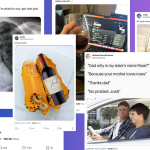If you’re a TikTok girlie, you’ve probably seen videos that feature Halara clothing. If you’re also a marketer, you may be wondering: How did the brand start showing up everywhere?
It all started, as it often does, with organic content.
One of the earliest viral posts featuring the DTC athleisure brand came in March 2021 from influencer couple Meg and Jack, where Meg surprised Jack while wearing a Halara dress. The post has been viewed nearly 2 million times, and the brand, which began posting on TikTok that same month, took notice, Gabby Hirata, Halara’s global brand president, said.
Halara, which was founded in 2020 by Joyce Zhang, often places paid advertising behind posts like these, which Hirata said has been integral to the brand’s virality. In the past two months, as videos of Halara’s wide-leg and three-button work pants have spread like wildfire on TikTok and Instagram, more than half a million of those two styles were sold on the brand’s website and through TikTok Shop. Halara has also employed affiliate marketing as a way to encourage influencers and ambassadors to spread the word about the brand.
User-generated content that highlights the brand’s clothing and is “rooted in the personal experience, very authentic, showing insecurity and talking very candidly…performs really, really well,” Hitara told Marketing Brew.
Creator first
Halara’s marketing team is especially focused on sourcing and building relationships with creators, as well as scouring social media for Halara-related videos and clothing recommendations that are already finding traction with audiences, Hitara said. There’s some incentive for creators: Halara gives some of them items in exchange for reviews. Some creators are also compensated through a mix of partnership fees and sales commissions on purchases made by users who shop through creator-specific links to the Halara website.
Halara has been paying creators for as long as it has been a company, Hirata said, and the brand has since worked with “probably thousands of content creators around the world,” Hirata said.
Get marketing news you’ll actually want to read
Marketing Brew informs marketing pros of the latest on brand strategy, social media, and ad tech via our weekday newsletter, virtual events, marketing conferences, and digital guides.
Creators aren’t the only way Halara looks to reach potential customers. Members of the brand’s affiliate program can earn a 5%–20% commission on orders made by users who navigate to Halara’s site through an affiliate link, according to the brand’s website.
College clothes
Beyond creator content and its affiliate program, Halara is investing in college students to help drive brand awareness and sales through a campus ambassador program. “We pay them like a contractor to run big booths in colleges, like in the central square,” Hirata said. The brand has held over 20 events on campuses since September 2022. Halara has worked with students in sororities and other campus organizations at schools including Texas A&M and UC Berkeley, according to Instagram posts from the brand.
Nonstudents can apply to be Halara brand ambassadors, too, and while there is no minimum follower requirement for applicants, admitted ambassadors are expected to “collaborate offline on events and projects” as well as submit product reviews in monthly surveys, according to the website. In return, ambassadors receive a 15% discount on Halara and a 10% commission on sales.
In the future, Halara hopes to add more athletes to its ambassador program, Hirata told us. The brand has already begun to ramp up athletics activations, recently hosting a booth at the Albany Pickleball Tournament in New York earlier this month.
“There are certain types of sports that are Halara, like ice skating, skateboarding, and pickleball,” Hirata said. “They’re just sports with a flair, like a personal expression.”
The ambassador program isn’t the only thing the brand is looking to grow this year. Be on the lookout for pop-ups in New York this year, Hirata told Marketing Brew.
Read the full article here










